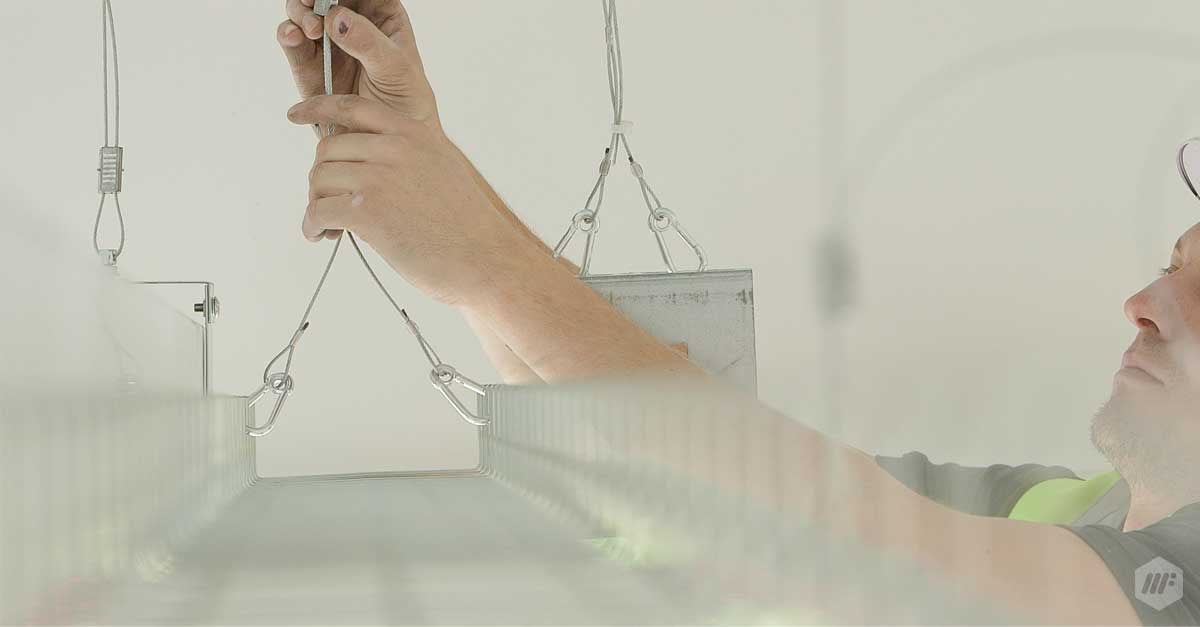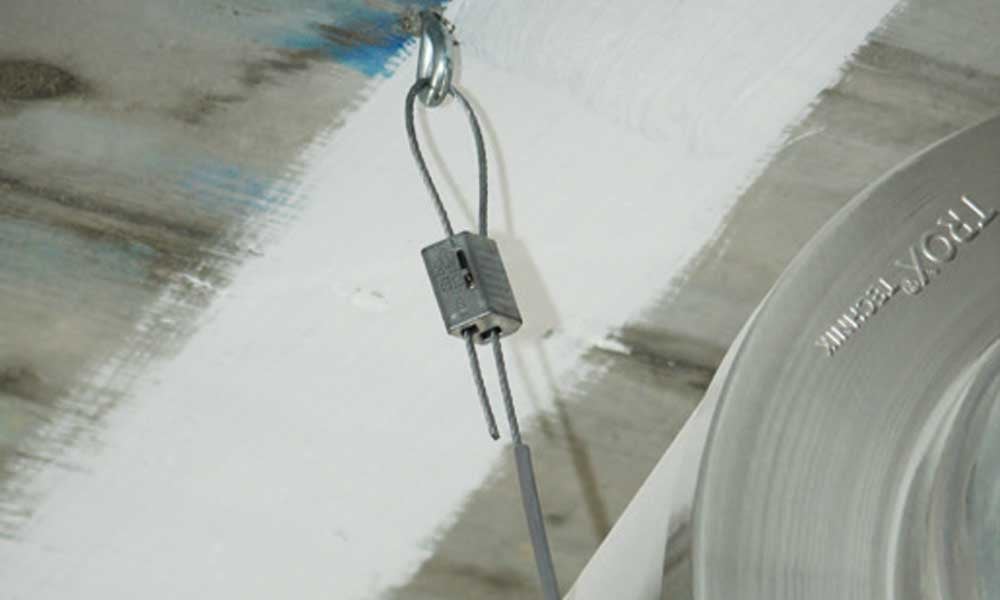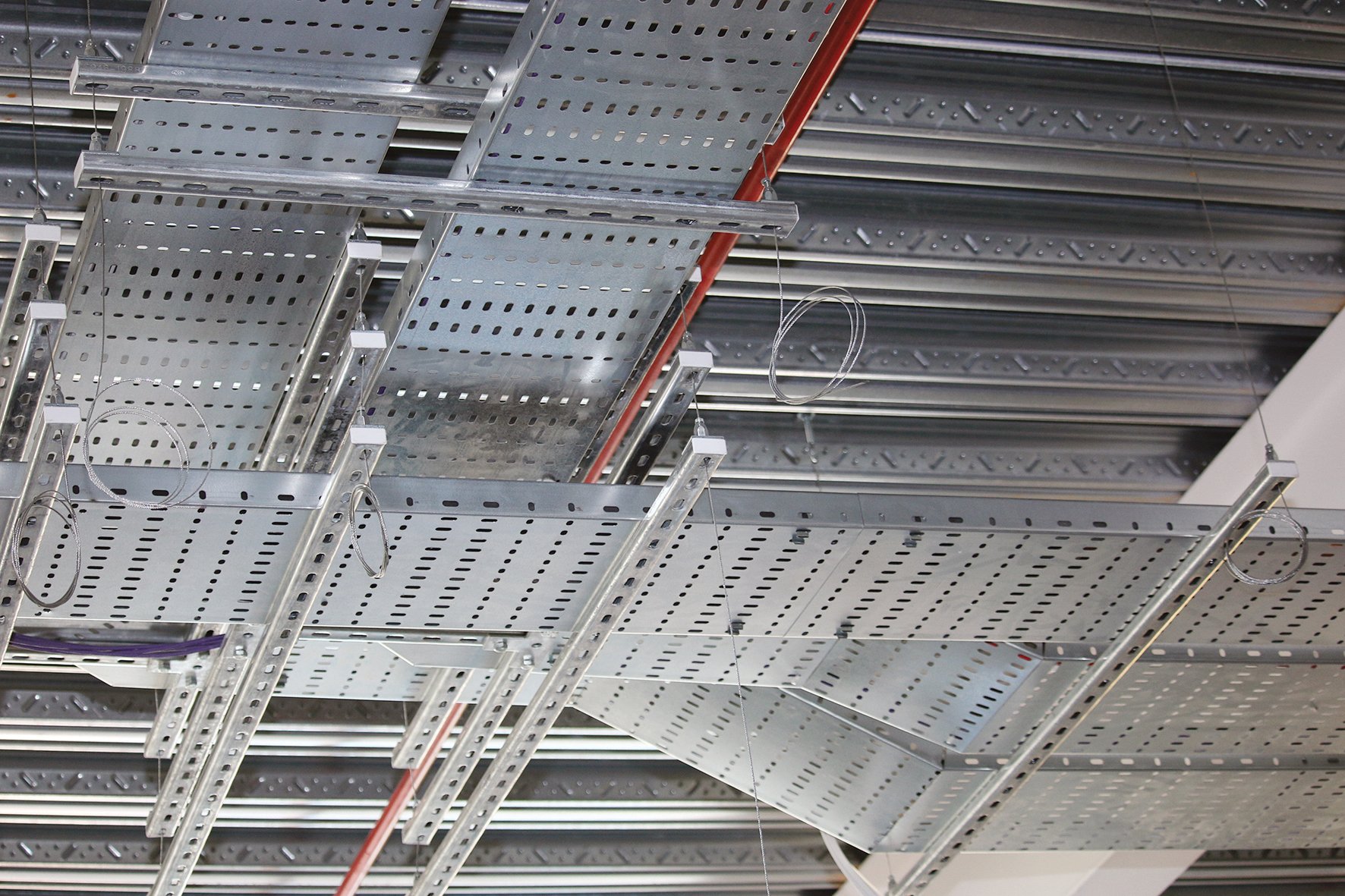Wire suspension systems: they’ve been around for a while, but despite their potential, aren’t used as much as they could be. Even with their numerous benefits and decades-long existence, they're controversial and there seems to be a preconceived notion that they’re inferior. This is primarily attributed to traditionalism – as is the case with many practices in the construction industry. Many baulk at this system because of its inadequate appearance and assume it’s won’t be effective for their applications. While we do sell wire suspension systems, namely by Zip-Clip, this article is intended to be an objective and honest review of the system, opinion aside, to help you better understand it and its suitable applications.
It'll cover the following:
- What is a wire suspension system?
- What are the advantages and disadvantages of wire suspension systems?
- Why shifting towards wire suspension systems will bring us closer to Net zero
- How moving away from traditional threaded rod system can reduce Installation time → advantage 2
- Why wire support systems performance data can be relied upon → advantage 3
- Why a lightweight suspension system can help an M&E installation disadvantage→ advantage 1
- How can wire flexibility provide accurate performance data - disadvantage → advantage 2
- When is a wire suspension system right for you?
What is a wire suspension system?
So, what are we even talking about? Wire suspension systems, also called rope suspension systems, are alternatives to the traditional threaded rod suspension methods. In its basic form, the wire secures the load of a product which is suspended from a ceiling. It is usually made with pre-galvanised or stainless steel.
What are the advantages and disadvantages of wire suspension systems?
Let’s break down the advantages and disadvantages of a wire suspensions system, particularly in comparison with the traditional threaded rod system.
Why shifting towards wire suspension systems will bring us closer to Net Zero → advantage 1
Firstly, traditional systems require more volume than wire systems, resulting in 33% in savings on components. This in turn reduces the overall cost of installation. This also means wastage is greatly diminished. While the traditional rod comes in 3 metres lengths, the 2mm wire comes in a coil of 100 metres, making it much more convenient and giving the ability to cut off only as much as you need. You could additionally come back to the same coil and use it for your next installation. The same can’t be said about the 3m lengths – for example, if you’re only using 2.5 metres, the surplus 500mm would just be chucked out.
Not only that, but one shipping container of 2mm wire has a total length of 1.44 million – to get the same length and load-bearing capacity from a traditional system, you would need 32 containers full of 10mm rods. That’s quite the difference, don’t you think?! Not only does this make transport much less of a hassle as well, but it means using wire systems is also much better for the environment as it reduces CO2 commissions significantly – by 92.6%, to be exact (yes, you read that right!). If more contractors implement these environmentally-conscious and efficient methods, it would definitely bring us closer to the Net Zero 2050 target, and it wouldn’t seem far-fetched

How moving away from traditional threaded rod system can reduce Installation time → advantage 2
In terms of installation, wire systems are much quicker and easier to install than threaded rod. As an M&E contractor, meeting deadlines is surely one of your main concerns, so the 50% reduction in installation time is noteworthy. Moreover, limited tooling is required – you’d really only need a pair of wire cutters and something to fix it to the ceiling, such as a drill. In contrast, threaded rod suspension systems might need a saw/grinder, slitted disks, transformers, spanners, extension cables, angle grinders, etc. This all accounts for less labour which could in turn reduce labour costs. To add, wire systems are very adjustable – bracket solutions aren’t complicated anymore, you know! It doesn’t hurt that they look aesthetically neater and easier on the eyes, too.
Why wire support systems performance data can be relied upon → advantage 3
An important benefit that comes with wire suspension systems is accountability and traceability with performance data. Typically, for a congested service corridor where the ceiling has a pitch, threaded rod is dropped at an angle, making performance data redundant. Whereas, for wire systems at an angle, performance data can be given. You can trace the origin of the product back to the manufacturer who has the data to back up the testing.
Why a lightweight suspension system can help an M&E installation disadvantage → advantage 1
A common misconception that discourages many from wire suspension systems is that the load-bearing capacity is greatly reduced when compared to threaded rod. You might think ‘how can something so thin and lightweight be sturdy enough to carry the weight I need it to?”. In reality, its lighter weight could prove beneficial when it comes to anchoring it to the ceiling, and in most cases, wire can actually perform just as well, if not better, than threaded rod. In rare situations, if you want to significantly increase your load, for example, then it’s possible traditional methods would be better suited. If we’re being meticulous, rod will always technically have more tensile strength than wire. But this is irrelevant because it’s actually excessively strong and the anchor fixing it to the ceiling will most likely fail way before the rod does. In which case, your comparison wouldn’t be wire vs. threaded rod; rather, it would be anchor vs. load capability. This leads us to another rabbit hole because the load capabilities depend on a variety of factors - such as the substrate, the environment, etc. in order to find out the anchor needed to be specified and therefore its load capabilities. Phew, a lot to cover.

How can wire flexibility provide accurate performance data – disadvantage → advantage 2
Another deterrent is the flexibility and movement that comes with wire. This is viewed as a ‘bad thing’, but what many don’t understand is that it can actually pose an advantage, and rigidity isn’t always good. You can design it in a way that it moves where you want it to. A great example of an instance where rigidity is a nuisance is if you want to fix to the underside of a sloping roof. What happens alarmingly way too often (installers, I’m talking to you!) when fixing the threaded rod, is bending it to accommodate the sloping ceiling. This then completely distorts the performance capabilities and all the load data goes out the window – null and void. Don’t do that!!! Instead, you can simply use wire and a fixing with a loop, thread the wire into it and, because of its flexibility, it’ll just drop correctly.
However, while you do want movement to a certain degree and sometimes it’s required, you equally want some rigidity and in some cases, it can be a con if it’s not accounted for. For example, in heavier weight, mechanical applications. If you’ve got pipework, swinging can apply stress on the joints and connection points. One that can be overcome, though, with a suitable design.
The solution to this would be anchoring the system at critical points to stabilise it. There are a few ways to do this: the first is attached horizontal wire to the walls on the sides to use as bracing. The other is more traditional: placing rigid support, such as channel, between every few metres. Through speaking with a specialist that understands wire/rope suspension systems and how they perform, it can be designed adequately to include bracing in the right places so that movement is kept to a minimum (but enough so it’s not too rigid). While it may seem antithetical to go through all this trouble, you still get all the aforementioned benefits (fast install, lighter, cost-effective, etc.) which, if done properly, far outweigh the downsides.

When is a wire suspension system right for you?
Taking all of the above into account, you may be thinking “where has this system been all my life?!” or you may still be sceptical.
I suppose you shouldn’t look at it in such a black or white way i.e. threaded rod vs. wire. Because the products are so different, how they perform and connection points, you can’t make a low-resolution comparison. Threaded rod will always overperform anyway, so take that out of the equation and rather, think of the load that you’re presented with, and whether you really need something as heavy-duty as rod – because if not, your end result will still be the same, but one option’s journey is much longer and rockier.
That’s why instead, it’s important to go for a designed solution that looks at the minimum requirements based on the calculation data, and finds the optimal solution that fits said requirements, whilst still considering time, cost, materials, etc. If you engage with somebody in the supply chain that understands both situations and can identify what you need and engineer it in a way that’s value-driven, you might find that a wire suspension system would be suggested as the prime solution because it’s adequate for the loadings. There’s no point in going to extremes if you don’t need to. Contractors will often cross out this option based on their own assumptions when, in reality, the design teams (usually) know what they’re doing and wouldn’t suggest an unsuitable solution.
Bracketry can be a headache – but that isn’t a problem with wire suspensions. In the long run, end-users are more likely to use wire suspension systems than threaded rod systems purely because it is engineered as one complete bracket and traceability. No pressure, but, if you’re in this industry as an engineer or end-user you’re responsible for ensuring you’re up to speed with modern practices.
If you only prefer traditional methods with traditional products, it’s not for you. If you like to use innovative products but install them traditionally, reacting completely to the site environment, then rope suspensions systems might be for you – although this brings up the ‘provability’ issue. If you do prefer using innovative products with provable and pre-planned designs behind them, then they’re definitely something you should be interested in. In the end, it really comes down to you and your preferences – but you could be missing out!



